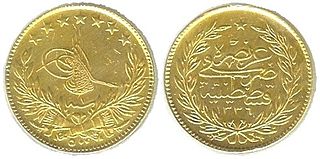
Sterling banknotes are the banknotes in circulation in the United Kingdom and its related territories, denominated in pounds sterling.

Clydesdale Bank is a trading name used by Clydesdale Bank plc for its retail banking operations in Scotland.

The United States ten-dollar bill ($10) is a denomination of U.S. currency. The obverse of the bill features the portrait of Alexander Hamilton, who served as the first U.S. Secretary of the Treasury. The reverse features the U.S. Treasury Building. All $10 bills issued today are Federal Reserve Notes.
The pound is the currency of Guernsey. Since 1921, Guernsey has been in currency union with the United Kingdom and the Guernsey pound is not a separate currency but is a local issue of sterling banknotes and coins, in a similar way to the banknotes issued in Scotland, England and Northern Ireland. It can be exchanged at par with other sterling coinage and notes.

The Egyptian pound is the currency of Egypt. It is divided into 100 piastres, or ersh, or 1,000 milliemes.

The pound was the currency of New Zealand from 1840 until 1967, when it was replaced by the New Zealand dollar. Like the pound sterling, it was subdivided into 20 shillings each of 12 pence.
The pound was the currency of the Gambia between 1965 and 1971. Gambia used the British West African pound until it issued its own currency on October 5, 1964. In 1971, the dalasi replaced the pound at a rate of £1 = D5. 1 pound was made up of 20 shillings, each shilling consisting of 12 pence.

The pound was the currency of the Union of South Africa from the formation of the country as a British Dominion in 1910. It was replaced by the rand in 1961 when South Africa decimalised.
The island of Alderney has its own currency, which by law must be pegged to that of the United Kingdom.

The Hyderabadi Rupee was the currency of the Hyderabad State from 1918 to 1959. It coexisted with the Indian rupee from 1950. Like the Indian rupee, it was divided into 16 annas, each of 12 pai. Coins were issued in copper for denominations of 1 and 2 pai and ½ anna, in cupro-nickel for 1 anna and in silver for 2, 4 and 8 annas and 1 rupee.
Banknotes have been issued for use specifically in Northern Ireland since 1929, and are denominated in pounds sterling. They are legal currency, but technically not legal tender anywhere. This is not uncommon as most bank notes are not recognised as tender. However, the banknotes are still widely accepted as currency by larger merchants and institutions elsewhere in the United Kingdom. Issuing banks have been granted legal rights to issue currency, and back the notes with deposits at the Bank of England.
The pound was the currency of Southern Rhodesia. It also circulated in Northern Rhodesia and Nyasaland. The pound was subdivided into 20 shillings, each of 12 pence.
The pound was the currency of Western Samoa between 1914 and 1967. It was subdivided into 20 shillings, each of 12 pence.

The pound or lira is the currency of Lebanon. It was formerly divided into 100 piastres but because of high inflation during the Lebanese Civil War (1975–1990) the use of subdivisions was discontinued.
Banknotes have been issued by the Bank of Ireland for circulation in Northern Ireland since 1922.
Banknotes were issued by the Commercial Bank of Newfoundland at various times between 1857 and 1888. The notes are quite rare.
The pound was the currency of Prince Edward Island until 1871. It was divided into 20 shillings, each of 12 pence. It was replaced by the dollar in 1871. Initiall sterling coin circulated, together with locally produced coins and paper money.

The lira was the currency of Ottoman Empire between 1844 and 29 October 1923 when it was replaced by the Turkish lira. The Ottoman lira remained in circulation until the end of 1927.

Banknotes of the Australian pound were first issued by numerous private banks in Australia, starting with the Bank of New South Wales in 1817. Acceptance of private bank notes was not made compulsory by legal tender laws but they were widely used and accepted. The Queensland government issued treasury notes (1866–1869) and banknotes (1893–1910), which were legal tender in Queensland. The New South Wales government issued a limited series of Treasury Notes in 1893.

The Royal Bank of Scotland £10 note, also known as a tenner, is a sterling banknote. It is the third smallest denomination of banknote issued by The Royal Bank of Scotland. The current polymer note, first issued in 2017, bears a portrait of scientist Mary Somerville on the front and a pair of otters on the reverse.











